Klein Quenstedt
|
Klein Quenstedt
City of Halberstadt
Coordinates: 51 ° 55 ′ 16 ″ N , 11 ° 3 ′ 49 ″ E
|
||
|---|---|---|
| Incorporation : | January 1, 1996 | |
| Postal code : | 38822 | |
| Area code : | 03941 | |
|
Location of Klein Quenstedt in Saxony-Anhalt |
||
Klein Quenstedt is a district belonging to the city of Halberstadt in Saxony-Anhalt .
location
The place is north of Halberstadt. To the west is Neu Runstedt , to the east is Groß Quenstedt . The streams Assebach and Runstedter Bach flow through Klein Quenstedt . The Huy ridge runs northwest of the village . The Magdeburg – Thale railway runs southeast of the village .
history
Klein Quenstedt was first mentioned in a document from 1185 as Wester Quenstedt . On April 26, 1185, Bishop Dietrich donated two hooves to Halberstadt Cathedral. Klein Quenstedt belonged to the Diocese of Halberstadt . The name is said to be derived from the Germanic word for cow, Quena . Witekke Castle , which served as the residence of the von Quenstedt family, was located on the Warmholzberg south-east of the village . In the following years, Klein Quenstedt was mentioned several times. The nobles von Suselitz gave the Halberstadt Cathedral four Hufe Acres in Klein Quenstedt in 1186. In 1197 Grand Vanguard Ludolf sold two hooves in Klein Quenstedt to the monastery of Our Dear Women. In 1236 Johann the Chandler donated seven acres to the Halberstadt Heilig-Geist-Hospital in Klein Quenstedt. It is said that the Burchardi monastery had three hooves in the place. According to a document from Bishop Albrecht from 1313, the Jacobi monastery also owned land in Klein Quenstedt. The first documented mention of a mill from Klein Quenstedt comes from the year 1237. The village church of Klein Quenstedt existed since 1286.
The Knights Templar had a permanent home on the outskirts of Klein Quenstedt, with its own church and two Hufen land. With the support of the Knights Templar, the robber knighthood, which is problematic for Klein Quenstedt, is said to have been fought. On April 26, 1306, the Templars sold their Klein Quenstedt estate.
In Klein Quenstedt, cabbage was grown to a particular extent for the needs of the surrounding monasteries. In 1391, heavy rains between April and autumn resulted in an extensive crop failure with subsequent famine and a plague epidemic that lasted until 1393. In 1489, such heavy snowfall is recorded that large trees fell off and floods occurred in the spring, which made food more expensive. In 1517 hail and storm destroyed the entire harvest. Something similar happened in 1551. On July 18 of this year a heavy storm with hail, heavy rain and thunderstorms fell on the Huy. The water levels in Runstedter- and Assebach rose sharply and led to a flood in Klein Quenstedt, which also destroyed several houses.
The plague reappeared in 1563 and 1577. In 1564 Klein Quenstedt had 60 households. In 1589 four free and 43 unfree landlords were given for the place. In 1597 there was a massive occurrence of hamsters and mice, which were the cause of a bad harvest. At the same time, the plague broke out again in 1597/98. In the 16th century, the robber Simon Bingelhelm was up to mischief in Klein Quenstedt.
During the Thirty Years War , there was also billeting and destruction in Klein Quenstedt. In 1625 there were at times 5 regiments with 15,000 people from the Gallas Ifolani in and around the village. The food and cattle of the population were requisitioned, houses from which they were not or could not be delivered were burned down. There were similar situations in the following years. The population became impoverished and hungry, and the plague broke out again in 1636. The years 1638 to 1643 were particularly bad again.
In 1684 there was another crop failure, and in 1686 there was another mouse plague.
In 1701 Klein Quenstedt was incorporated into the Brandenburg-Prussian district of Oschersleben. Economically, agriculture and fishing remained important in Klein Quenstedt. The cultivation of flax emerged , which also resulted in oil mills.
On July 24, 1712, after a storm with heavy rain, the town center was flooded and cattle drowned. There were also major storms in 1716, 1729, 1731, 1740 and 1742. A cattle epidemic is reported from 1754, which killed a third of the livestock.
There is a documentary mention of a school in the village from 1746. It was probably on the Kirch or Pfahlberg. In 1752, 437 landowners were named for the Klein Quenstedts district.
During the Seven Years' War between 1756 and 1763 there were repeated billeting of troops, especially French troops , which in turn was associated with great burdens for the population.
In 1794 the winter was so mild that the farmers were already tilling the fields in February. However, a good harvest was prevented by frost on May 25th. In 1801, the harvest was destroyed on August 26th by heavy hail.
In the course of the coalition wars against Napoleon , French troops moved in in October 1806. Eight Prussian refugees are said to have been shot at the confluence of the Assebach and Runstedter Bach rivers . There was billeting again and increasing poverty. Conscripts were drafted into the army of the newly formed Kingdom of Westphalia , to which Klein Quenstedt now belonged. In 1809 a total of 1,000 Dutch people were quartered in Klein Quenstedt and the neighboring towns of Groß Quenstedt and Emersleben , which was a considerable burden. On May 30, 1813, Russian dragoons and Cossacks, allied with Prussia, moved in and ended French rule. A victory celebration took place on November 14, 1813, with the Prussian eagle attached to the parish hall. After the end of the war, the economic situation of the population improved significantly.
In 1829 Klein Quenstedt had 437 residents. There was a windmill on a hill on the east side of the village.
The summers of 1834 and 1836 were so dry that the streams dried up. On the other hand, on April 9, 1837, there was such a strong snow storm and thunderstorm that the snow on the road to Klein Quenstedt piled up to three meters. The thaw and rain that began at the end of April led to considerable flooding.
In 1848, like in other communities, a vigilante group was set up in Klein Quenstedt. During this time the cultivation of sugar beet gained importance.
Buildings
In the resort are 15 in the local directory monument registered monuments , including the village church Klein Quenstedt , which located in the village water mill , the Riechertsche mill , and the farmhouse plan 16 .
Personalities
The German cactus expert Carl Knippel came from Klein Quenstedt , after whom several types of cacti are named.
literature
- Klaus-Peter Gebauer: Chronicle of Klein Quenstedt , without a year, probably 2016.





